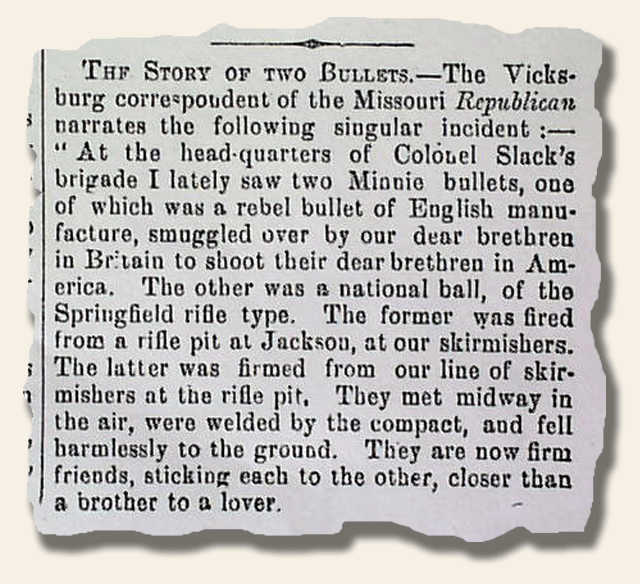The Traveler… traveling to Rio de Janeiro… part of the “health test”??
February 10, 2011 by The Traveler · 1 Comment
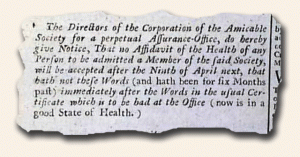 I decided to take my travels a like further back in time and to a place that always intrigued me. Through letters from Boston and Philadelphia, The London Gazette dated February 12, 1711 reported on a vessel that had been shattered from Rio de Janeiro. The French had landed and were being beaten off with the reinforcement of eight thousand men from the mines… the French retreated.
I decided to take my travels a like further back in time and to a place that always intrigued me. Through letters from Boston and Philadelphia, The London Gazette dated February 12, 1711 reported on a vessel that had been shattered from Rio de Janeiro. The French had landed and were being beaten off with the reinforcement of eight thousand men from the mines… the French retreated.
In my readings, I see numerous “An Act..” within newspapers, but found this one quite unusual. “An Act to enable John Lord Gower, Baron of Stitnham, an Infant, to make a Settlement upon his Marriage.” I wonder what the terms of the settlement were??
Last, the back page had an announcement about “The Corporation of the Amicable Society for the Perpetual Assurance-Office” for the Affidavit of the Health. The way the announcement read, this may have been part of the qualification testing… if you understood it all, then you were in good (mental) health.
~The Traveler
So, what’s a “humhum”?
January 8, 2011 by TimHughes · 2 Comments
This advertisement appeared in the “Middlesex Gazette” of Middletown, Connecticut, on June 13, 1803. I have no idea what a “humhum” is. Do any of you?
Cigarettes do not cause cancer…
December 18, 2010 by TimHughes · 1 Comment
Hindsight means everything when it comes to history, and browsing through the pages of newspapers from years ago can often turn up reports which now are almost humorous in their inaccuracy. One item: “Clears Cigarettes As Cancer Source”, which appeared in the July 10, 1928 issue of the “New York Times“, provides some interesting reading in light modern scientific research about the effects of cigarette smoking and cancer.
Old age is relative…
October 23, 2010 by TimHughes · Leave a Comment
Enjoy the following, which appeared in an 1857 newspaper: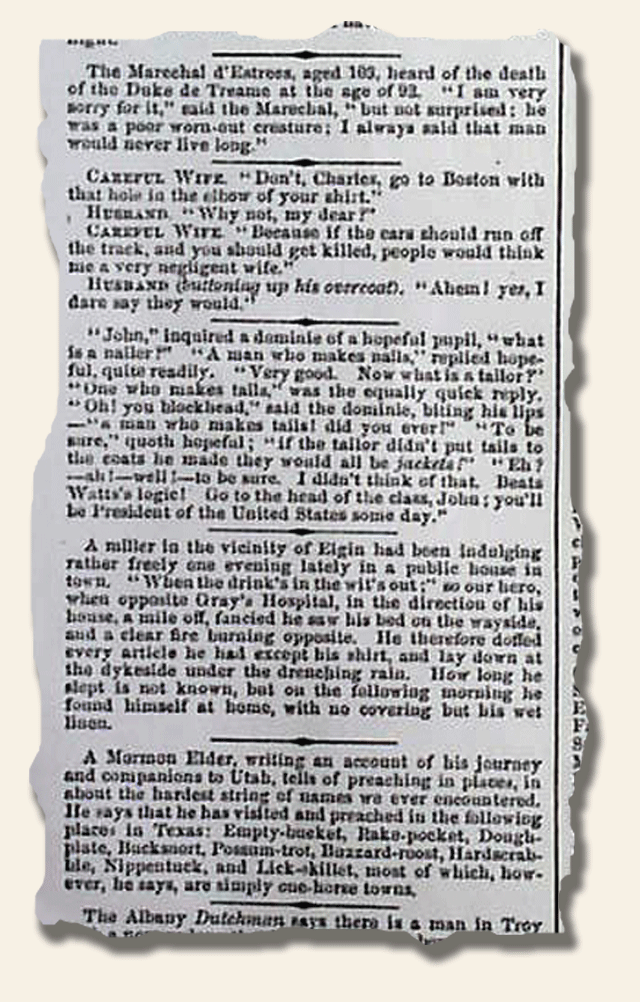
Understated caption, or overstated print…
August 28, 2010 by TimHughes · Leave a Comment
This illustration appears in “Frank Leslie’s Illustrated Newspaper” dated August 5, 1871. The caption notes: “Mount Washington Storm Signals–Use of the Anemometer under difficulties.” Either the print is overstated or the caption is understated. I’m guessing the former, but it makes for a fun image.
The Traveler… who really invented “the talkies”?
August 26, 2010 by The Traveler · Leave a Comment
Today’s journey, through The Christian Science Monitor dated August 26, 1910, took me on the train ride with Colonel Roosevelt as he was traveling across the states on his campaign tour. I found a segment a bit amusing… “At Erie the Colonel spoke to fully 5000 people. At Dunkirk a crowd nearly as large surrounded the train, and some one shouted, ‘Hello, Teddy!’ ‘I used to think it lowered my dignity to have them call me Teddy,’ the colonel said to his party in an undertone, ‘but do you know I am getting to like it now.'” A this point in time, one just somewhat “assumes” that he was always called Teddy.
 While looking further into the issue, I found a one paragraph article with a headline “Mr. Edison Works On A New Device” and I just had to read it. “Moving pictures that talk, reproducing not only the action, but the spoken words of actors shown on the canvas, promise to revolutionize the moving picture business and the announcement that a machine that will combine the perfected phonograph with the present motion picture camera is being constructed in the laboratory of Thomas A. Edison in West Orange, has created a stir among inventors.”
While looking further into the issue, I found a one paragraph article with a headline “Mr. Edison Works On A New Device” and I just had to read it. “Moving pictures that talk, reproducing not only the action, but the spoken words of actors shown on the canvas, promise to revolutionize the moving picture business and the announcement that a machine that will combine the perfected phonograph with the present motion picture camera is being constructed in the laboratory of Thomas A. Edison in West Orange, has created a stir among inventors.”
This made me wonder just when were “talkies” invented and who invented it? Was this ground-breaking news? I did some researching through google. In the late 1890’s, there were some sound to movies but each person had to wear a listening device — early headsets?? Mr. Edison is mentioned as to be working on creating a special machine to make the “talkies” but the first talk was not to be until 1927 with the release of The Jazz Singer.
~The Traveler
The Traveler… a ghost of a dog…
August 12, 2010 by The Traveler · Leave a Comment
 This week I did not select an issue of today’s date, instead I found the Connecticut Mirror dated August 13, 1810 instead. The front page of this issue begins with providing to the public the celebrated secret message of President Jefferson, on the 6th of December, 1805. This message was in respect of the relations of the United States with Spain and France concerning Louisiana. When I first saw this, I thought back to the 1970’s when Watergate occurred with the “missing minutes” of tape. Here they had secret messages that finally were revealed to the public five years later.
This week I did not select an issue of today’s date, instead I found the Connecticut Mirror dated August 13, 1810 instead. The front page of this issue begins with providing to the public the celebrated secret message of President Jefferson, on the 6th of December, 1805. This message was in respect of the relations of the United States with Spain and France concerning Louisiana. When I first saw this, I thought back to the 1970’s when Watergate occurred with the “missing minutes” of tape. Here they had secret messages that finally were revealed to the public five years later.
The story that was the eye-catcher was found on the back page, entitled “Ghost of a Dog”. This comes from a Dublin paper reporting of a lady who was scratched by a neighborhood dog, but she viewed it as a “breach of hospitality” that she demanded an order of execution on the dog. This was done, in a strange manner, and the dog’s body was retrieved by some friends. With some very unusual tactics over a course of about three weeks, the dog was able to run about as usual, make his rounds to visit his old friends, including meeting up with the lady he had scratched. She was so terrified that she fell into fits and at the time of the report was near death. Now… what’s the old saying… what goes around, comes around???
~The Traveler
Interesting cure for a multitude of ills…
July 31, 2010 by TimHughes · Leave a Comment
This advertisement in the August 22, 1885 issue of “Harper’s Weekly” gives evidence as to how much times have changed. And I find it interesting that cocaine–a known stimulant–would be a cure for “sleeplessness” and “nervousness”.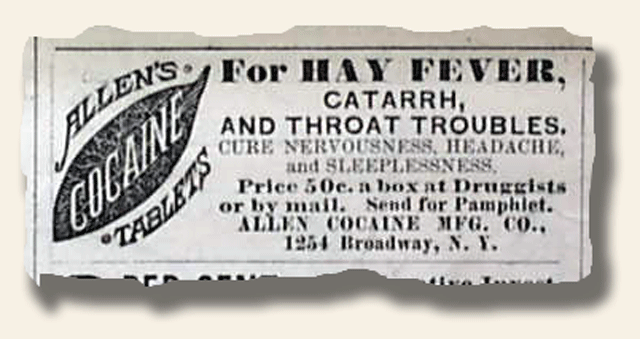
Non-compassionate approach to advertising…
July 24, 2010 by TimHughes · Leave a Comment
This ad is from the “Daily Delta” of New Orleans, March 29, 1861. The advertiser chose a hard-line approach to selling his product, claiming one is: “…laying the foundation stone for an early grave by your obstinacy and stupidity.”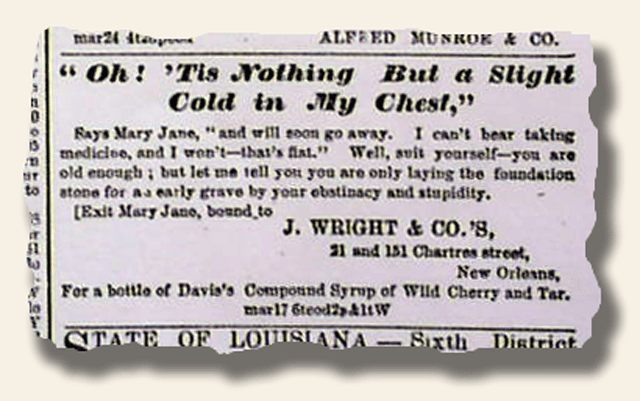
Poetic analogy from the battlefield…
June 12, 2010 by TimHughes · Leave a Comment
The “Bradford Reporter” newspaper from the small town of Towanda, Pennsylvania, October 22, 1863, contains: “The Story of Two Bullets” which provides a somewhat poetic analogy to a hopeful conclusion to the Civil War.